An oft-repeated suggestion concerning Australia’s military history is that there is only one remaining warship not yet located of those sunk in World War II. But how true is that?
Of course, most people assume that a lost vessel was lost in combat, with a concomitant loss of life. This is not necessarily the case. There are many vessels lost by accident, and a few that simply disappeared, and so may have met their end either in a fight or through misadventure. This article analyses both categories, and arrives at a conclusion.
First though, it’s worth asking why the location of ships is something usually desired. The answer is twofold: first if people died on board then relatives and friends want to know the location of a loved one’s grave. Second, quite often the shipwreck can provide the answers to a mystery. So, for example, the finding of HMAS Sydney, lost in a fight with the German raider Kormoran, was able to confirm the German account of the battle.
The criteria for inclusion is:
- The vessel must have been sunk in wartime.
-o-o-O-o-o-
- A list of all vessels sunk in the Navy’s entire history proved elusive; one of the only ones appears to be in Allen Lyne’s History of all 45 RAN Ships Lost during Service. Great work was done some time ago by the Naval Historical Society of Australia, compiling an excellent list of all military vessels lost to all causes – it can be found at the reference.[1] Further research is as noted.
-o-o-O-o-o-
- The WWII vessels include those of the Naval Auxiliary Patrol (NAP) a war-raised unit approved on 25 June 1941. The NAP, along with a number of channel patrol boats, was given the task of patrolling and safeguarding Australia’s inner harbours, ports, rivers and estuaries against enemy sabotage or attack. In May 1942 the NAP was transferred to the Royal Australian Naval Volunteer Reserve (RANVR).
-o-o-O-o-o-
- If the vessel sunk was grounded at the time of loss, it is listed as located.
-o-o-O-o-o-
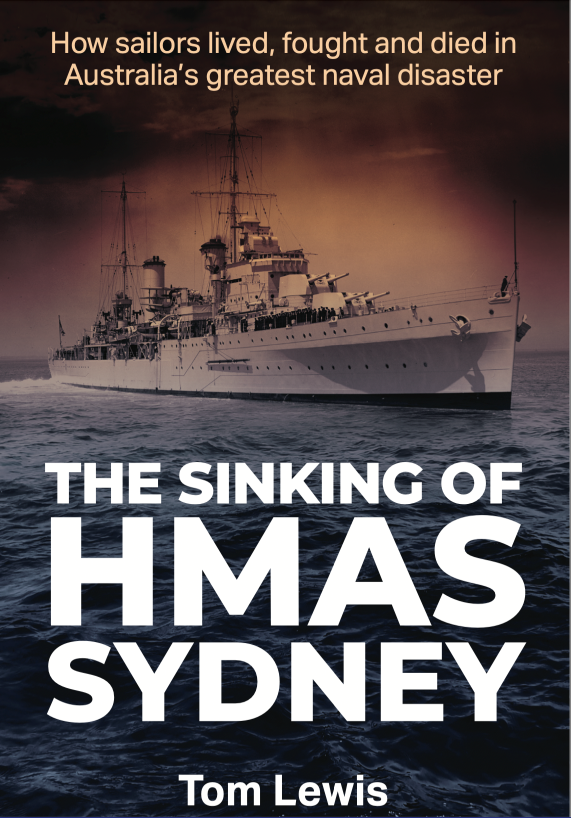
-o-o-O-o-o-
World War I
Just prior to beginning an analysis of WWII, it is worth noting briefly what happened in the previous world-wide war, albeit a much smaller conflict. The RAN lost two warships in the Great War of 1914-18. The most famous one was the submarine AE2, scuttled due to being cornered after carrying out an attack in the Sea of Mamora on 30 April 1915. No members of the ship’s company were lost in the action, but four died in captivity as Prisoners Of War. AE2’s wreck site is well known, having been found lying at 72 metres in 1998 in a Turkish shipping channel.[2]
The submarine AE1 was lost for many decades after disappearing near Rabaul. The submarine likely collided with an undersea mount. All 35 members of her ship’s company were lost.[3] The wreck was finally found east of Papua New Guinea, near Duke of York Island, in December 2017.
In summary it would seem there are no warships lost in WWI to Australia which have not yet been found.
World War II
In WWII the Navy lost the following ships due to enemy action, accident and mis-management. They are noted in chronological order with their wreck location details.
20 November 1940. HMAS Goorangai was the first casualty of war, when the auxiliary minesweeper was sunk in a collision with the liner Duntroon south of Melbourne. 24 men were lost in the accident. Sunk in only 15 metres of water near shore the wreck was demolished by explosive charges early in 1941.[4] Some reports say remaining items have been found and removed over the years. A memorial has been placed on the cliffs nearby.
30 June 1941. The destroyer HMAS Waterhen was the first combat loss of WWII when she was sunk by German air attack off Sollum in the Mediterranean. There were no fatalities, and the wreck has not been located.[5] Contrary to some expectations, the Mediterranean is a deep sea, reaching 5,000m in places, with an average depth of 1,500m. The finding of such wrecks therefore, is not likely to occur as a result of incidental diving or fishing.
19 November 1941. HMAS Sydney, the cruiser sunk off the West Australian coast on, has the dubious distinction of being the largest loss of life in action for the RAN, with 645 lives lost. The loss of the pride of the fleet – Sydney had distinguished herself in action previously – was the source of much angst for decades, due to her being sunk, according to Germans survivors’ accounts, by the less powerful surface raider Kormoron. The wreck was located in 2008, and at least according to this writer it bears all of the characteristics of the type of combat those survivors described. Sydney lies in extremely deep water and the wreck is unlikely to be visited except by government-approved scientific inspections.
27 Nov 1941. A week after Sydney disappeared, the Navy lost the destroyer HMAS Parramatta. On her way to Libya in the Mediterranean, she was sunk by an attack from the German submarine U-559. 138 RAN members went down with the ship. The wreck has not been located.[6]
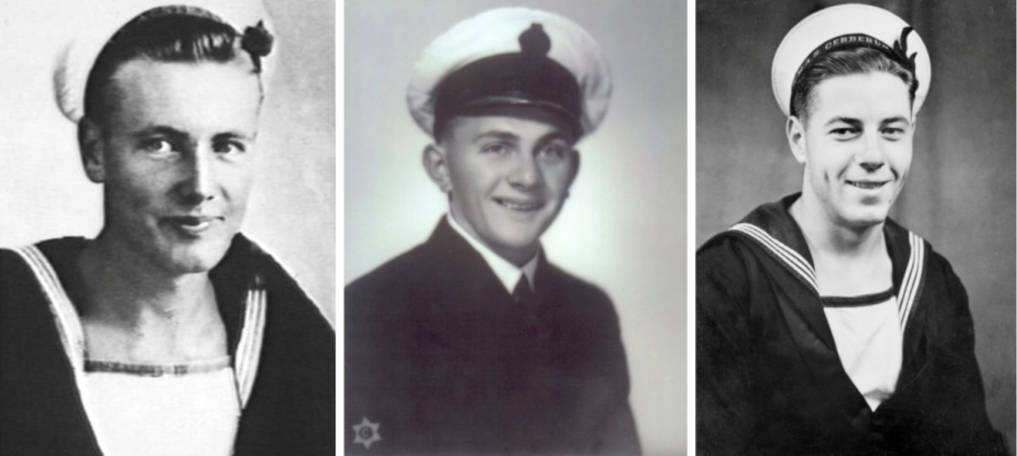
26 January 1942. The 13 ton patrol boat HMAS Sirocco caught fire and burnt to the waterline in Hobart. Whether the wreck was completely sunk is unknown, but as a wooden vessel little would remain.
19 February 1942. The Imperial Japanese Navy launched the largest air raid Australia has ever experienced on the port of Darwin. Four aircraft carriers sent 188 aircraft against the small town, aiming at its harbour, airfields and infrastructure. It was the first of some 208 raids against Australia’s north. The raid sent three vessels of the Navy to the bottom out of 11 ships sunk.[7]
-o-o-O-o-o-
- The lugger HMAS Mavie was sunk near the local wharves. She was a wooden vessel so the wreck broken up to a degree. Pieces were located and raised in following years, and much of the harbour wreckage was cleared in 1959-60 by – ironically – a Japanese salvage team.
-o-o-O-o-o-
- An ex-sailing ship containing coal fuel, the remains of the decommissioned HMAS Kelat’s wooden hull lie approximately one kilometre off the Darwin commercial port wharves. It is a popular dive site, and lumps of the coal fuel from the 1,849 ton vessel are scattered across the site. Cassells suggests she was bought by Fujita Salvage, but the author’s research does not support this, and in any event the Japanese company was trying to recover steel.[8]
-o-o-O-o-o-
- The 103 foot lighter Karalee was sunk as a result of damage received during the raid.[9] The wreck has not been found. Cassells suggest she was sunk “in the channel off the Boom Jetty” but the wreck did not turn up in the comprehensive survey the Navy carried of anchorages post-Cyclone Tracy (1974).[10]
-o-o-O-o-o-
- The other vessels sunk were the tanker British Motorist, coastal transport Zealandia, freighters Meigs, Mauna Loa, Neptuna, Florence D, Don Isidro, and the destroyer USS Peary. The latter had the largest loss of life on the day with 88 USN men dying. In an example of the confused world of wreck finding, her propellers and sections of the engines were found a few years ago some kilometers from where the rest of the wreck ended up.[11]
-o-o-O-o-o-
1 March 1942. HMAS Perth. A cruiser sunk in the Battle of the Sunda Strait in shallow water, this famous ship fought to the last along with USS Houston. 347 naval personnel, including three RAAF personnel and three canteen staff, did not survive the sinking. Sadly, the wreck was located in later years and has been sometimes salvaged by pirate salvage teams.
HMAS Yarra, a Grimsby-class sloop, was lost on 4 March 1942, 500 kilometress south of Java when her three vessel convoy was attacked by a flotilla of Japanese warship attack. 138 men lost their lives as the warship fought to the last. Her wreck has not been found.[12]
9 Apr 1942. HMAS Vampire, a destroyer, was escorting the carrier HMS Hermes when both were attacked east of Ceylon, now known as Sri Lanka, by large numbers of Japanese aircraft. After Hermes was sunk, with over 300 deaths, Vampire was sunk too, with nine men dying. [13] The wreck has not been located, despite a search in 2019 by the Sri Lankan and Australian navies,[14] and Hermes being located in 2002.[15]
12 May 1942. The 118 foot steel schooner Uribes was sunk off Rottnest Island with no loss of life. The wreck is in shallow water and a well-known dive site:
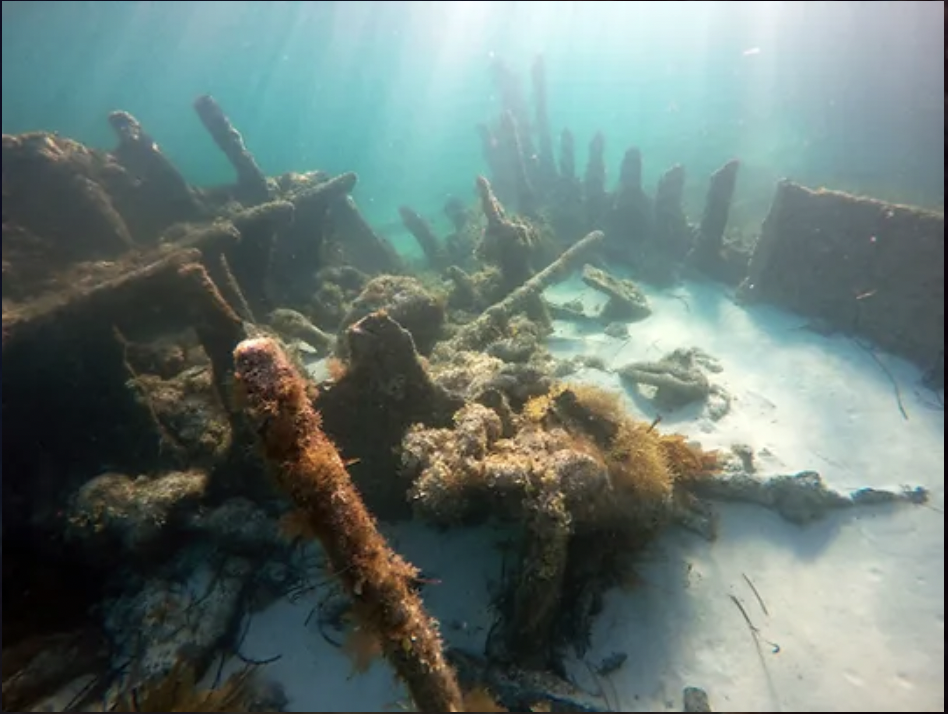
The Uribes had just finished loading machinery and 9 inch shells from the Oliver Hill gun battery when the engines failed as it steamed out of Thomson Bay. The ship’s anchors failed to hold the vessel off the beach and the 37 metre schooner was soon filled with sand and considered lost with all stores… Only a few metres from the beach, the wreck provides an easy afternoon snorkel but the site can at times be heavily buried by sand movement.[16]
31 May 1942. HMAS Kuttabul. This accommodation vessel was hit by a torpedo aimed at USS Chicago in the midget submarine attacks on Sydney. The converted ferry was later raised and the bodies of the 21 sailors who died were recovered.[17]
16 June 1942. The destroyer HMAS Nestor was in the Mediterranean engaged on escort duty when she was the subject of a German air attack. One hundred miles north of Tobruk, she was severely damaged, and when towing operations failed, she was scuttled. Four of her ship’s company had been killed in the attack and their only grave is the ship, which has not been found.
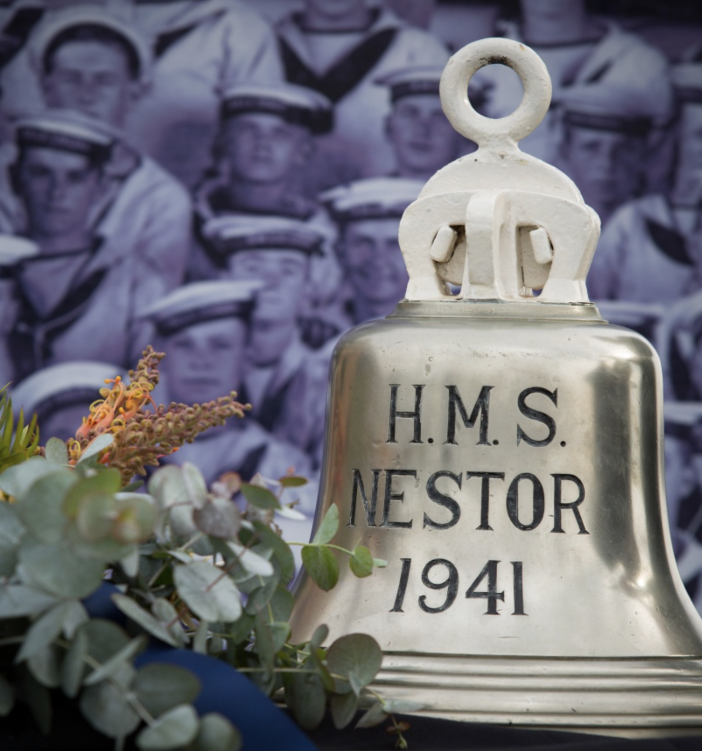
2 July 1942. The 35 ton cabin cruiser HMAS Nereus was destroyed by an accidental fire in Sydney Harbour with no casualties.[18] According to some accounts her fiery end was the source of much interest to viewers on the harbour shores.
HMAS Canberra. This cruiser was involved in the Battle of Savo Island on 8-9 August 1942, and was scuttled the next morning after the night action when she could not be saved. 84 men were lost. The wreck site, very deep, is well known and has been visited and photographed, most spectacularly by Bob Ballard. [19]
12 Sep 1942. The 38 foot launch Hulda had the distinction of being sunk twice. She was damaged by fire in September 1942 and sunk, and then raised and repaired. She was later sunk again near shore at Buna, New Guinea on an unknown date. [20]
23 September 1942. HMAS Voyager. This destroyer was lost after being lodged irretrievably on sandbars while offloading men and supplies on the southern coast of East Timor. There were no casualties, and the ship was destroyed by explosives to stop her falling into the hands of the enemy. The remains can still be seen on a beach today.[21]
23 September 1942. The 11 ton patrol vessel Siesta was destroyed by fire off Fremantle WA. No casualties were recorded.[22] Some salvage of items has been made. The wreck site is able to be visited by divers.
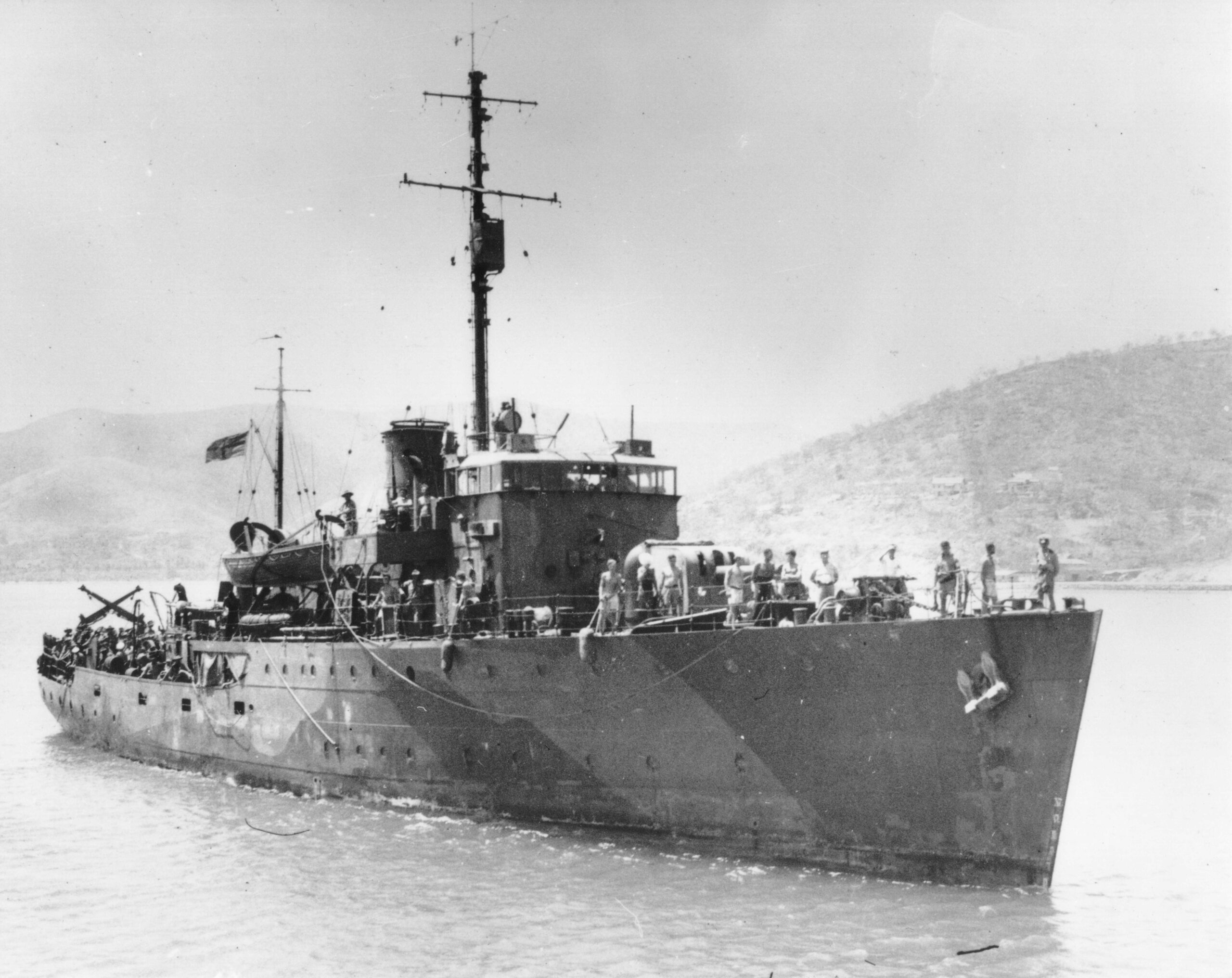
1 Dec 1942. HMAS Armidale, a Bathurst-class corvette, was sunk by overwhelming Japanese air attack south of Timor. 101 fatalities were recorded from the sinking and the struggle to survive afterwards. The shipwreck has not been found.[23] Ordinary Seaman Teddy Sheean, who fought with his Oerlikon gun to the last, was the latest Victoria Cross for Australia recipient, awarded in 2020 after decades of campaigning. He is the only RAN VC awarded.
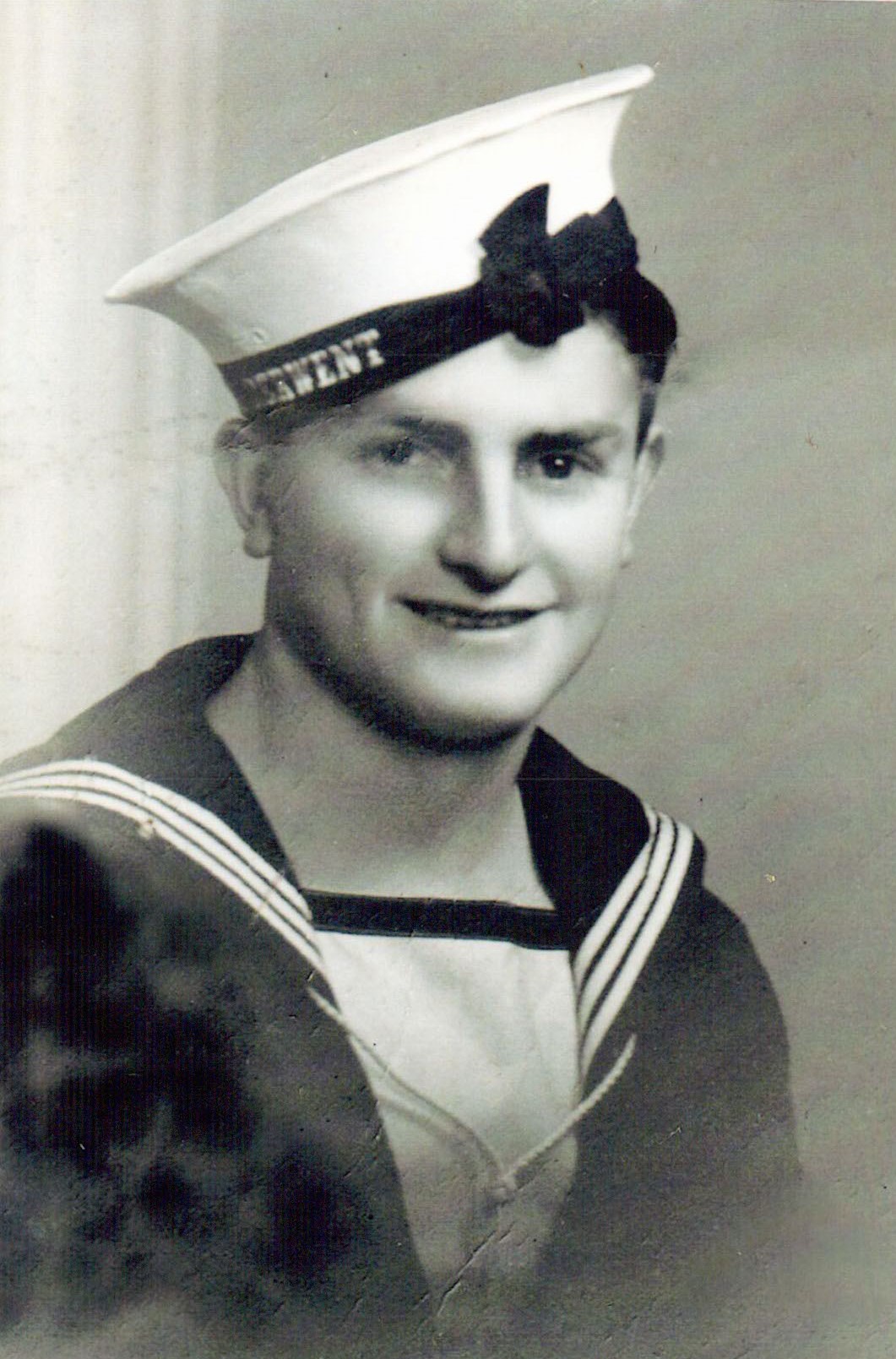
22 January 1943. HMAS Patricia Cam. Lugger bombed and sunk by Japanese air attack off the Northern Territory coast. Five sailors and three natives died. Reverend Kentish, forced aboard the Japanese floatplane, was later executed in Japanese-held territory, for a total of eight fatalities on board the ship itself or in the survival efforts afterwards. The wreck has not been located.
11 April 1943. The 45 ton lighter Yampi Lass was blown ashore in a storm in Darwin Harbour, and assessed as incapable of repair. The wreck was eventually sold in 1946.
7 May 1943. The 145 foot steam yacht HMAS Adele, which had once served as the tender Franklin at the RAN College, later converted to a stores vessel, was wrecked by a storm in Port Kembla, NSW. [24]
10 May 1943. HMAS Maroubra. This cutter was lost on whilst on a return voyage from Thursday Island to Darwin. Strafed by nine Japanese Zero fighters raiding the Milingimbi Island airstrip, she caught fire and was abandoned. The remains of the wreck can be seen on a beach north-east of the Milingimbi Mission.
11 June 1943. The Bathurst-class corvette HMAS Wallaroo foundered after collision with the US Liberty ship Henry Gilbert Costin off Western Australia west of Fremantle. Three lives were lost, and the vessel wreck has not been located.[25]
12 July 1943. The motor cruiser HMAS Silver Cloud was severely damaged by fire in Sydney Harbour, and was considered beyond repair. However what remained of her hull was purchased by the original builder, Lars Halvorsen & Sons, restored and sold, and she can still be seen in NSW waters today.[26]
7 Sep 1943. HMAS Starfish. This 38 foot raised deck motor cruiser was involved in a grounding near Wollongong, NSW and was sunk with no loss of life.[27]
17 Oct 1943. The auxiliary patrol boat HMAS Gladmor was destroyed by fire at Fremantle, WA with no loss of life.
Significant other wrecks
Mention is made here of other vessels which the uninformed reader might presume are Navy in some way or the other. There are often naval personnel present on such ships, but they are not warships.
Hospital ships are usually under naval command. Fifteen Australians were amongst the 123 deaths recorded in the loss of the hospital ship Warilda on 3 August 1918. Despite being lit up and clearly marked she was attacked and sunk in the Channel on her way back to Britain.[28] The Germans later claimed she was carrying arms, which was also the case with other hospital ships attacked in the war. The wreck was later located about 50m underwater, approximately mid-way in the English Channel[29] between Le Havre and Portsmouth, being found post-war at a date yet to be established. An underwater film of her can be found on YouTube, with one commentator noting – unusually – there that he had fished the wreck in the 1980s.[30] In general war wrecks with lives lost in most countries are protected from such interference.[31]
The control of hospital and transport vessels in the world wars was both clumsy and curious, but it worked to a fair degree. A good explanation comes from Christopher Milligan and John Foley’s Australian hospital ship Centaur: the myth of immunity:
The command of Australian hospital ships, while clear cut, nevertheless depended on the cooperation of a tri-partite mix of disciplines: army (medical), merchant marine, and naval (operations). Each ship was treated as a complete medical unit administered in the same way as an army general hospital; the only difference being its mobility. Invariably, the senior army medical officer on board (whatever his actual rank) became Officer Commanding Troops, usually known by his more popular title of ‘O.C. Troops’ or the even more compact ‘O.C.’. In command of the ship, from the point of view of its navigation, safety, day-to-day maintenance and crew discipline, was the captain, a merchant navy officer. Usually the entire crew were merchant marine. Where the ship went, its schedule or any special routing orders, became the responsibility of the RAN, no doubt in consultation with other military sources.[32]
Montevideo Maru. Although not an Australian ship, this vessel figures large in the country’s history, as it was the worst wartime maritime disaster. Transporting mostly Australian prisoners, the vessel was being used to take POW’s from Rabaul to Hainan when it was sunk by submarine attack to the north-west of the Philippines, on 1 July 1942. 1,054 people, mostly Australian prisoners of war and civilians who were being transported from Rabaul, lost their lives. The sinking is considered the worst maritime disaster in Australia’s history. The wreck of the Montevideo Maru was discovered on 18 April 2023, lying at over 4,000 metres depth.[33]
The hospital ship HMAHS Centaur was sunk on 14 May 1943 after being torpedoed by Japanese submarine I-178 near Brisbane. Of the 332 persons on board, only 64 survived, with 268 deaths. The Australian War Memorial advises:
A search led by David Mearns, who had previously lead the team that found the wrecks of HMAS Sydney and HSK Kormoran, discovered Centaur’s wreck on 20 December 2009. Centaur was located about 30 nautical miles off the southern tip of Moreton Island, off Queensland’s south-east coast.[34]
With the ship in over 2,000 metres of water, it is impossible for any dive attempt but the best-equipped to visit the site.
HMAT vessels
Ships with the prefix HMAT, signifying His Majesty’s Australian Transport, can be found in the annals of combat in both world wars. For example, in World War I seven transports were sunk: HMAT Geelong, Itonus, Marere, Afric, Ballarat, Seang Choon, and Barunga. With the exception of Geelong, which was lost after a collision with the freighter Bonvilston, all were sunk by German U-Boats, testimony to the new threat of submarine warfare. Deaths were recorded in several of the sinkings. In WWII, with the war being much bigger, many more than seven ships were lost.
The manning of HMAT ships often had naval personnel aboard. For example, as the RAN’s Sea Power Centre advises:
Transports were primarily crewed by Merchant Navy crews, but at least some had Navy detachments aboard. The first convoy had the 2NM, Captain Arthur Gordon-Smith, embarked in Orvieto, for example, as Principal Transport Officer for at least part of the journey.[35]
Naval personnel could also meet their deaths on board the Defensively Equipped Merchant Ships. The official historian noted:
During the war 37 officers and 1,070 ratings served as Defensively Equipped Merchant Ships’ personnel in the Royal Australian Navy. Imperial and Allied ships numbering 251 were supplied, or partly supplied, with R.A.N. personnel (D.E.M.S) as were 124 Australian ships.[36]
Some of this armament could be quite formidable in terms of close-quarter action against surfaced submarines. For example, Duntroon carried one 4-inch gun, a 12-pounder, two Bofors, and six Oerlikons as her defensive measures, manned by 27 embarked naval personnel.
The Navy’s loss of life for the entirety of WWII was 1,852 men. [37]
Army and RAAF losses
Both of these two Australian armed forces operated maritime sections in WWII. Although in general they were small vessels – launches, in the main – they too could present hazards to life from a range of causes, including enemy action. The RAAF’s were mainly concerned with “crash boats” – that is, vessels positioned suitably to pick up survivors from crashed aircraft en route to or from an operational area; and vessels to serve the needs of the many seaplanes and amphibious aircraft the Air Force operated in those days. The Army were using small craft to take personnel ashore, or pick up vehicles and machinery from beaches, and so on.[38]
The records are hazy, but it appears a major loss for the RAAF was the freighter Wanaka. On 15 December 1943, this ship of 2,259 tons, and a length of 277 feet (84.6m), taken up from trade by the Royal Australian Air Force, was returning to Australia when caught in a strong storm and heavy seas. Driven onto Eden Reef in Queensland, north of Cooktown, she capsized on her side, losing 10 men overboard. She was later repaired and towed to Sydney.[39] Her bell may be seen in the RAAF Museum at Point Cook.
Army’s losses have been tracked in one publication, but without notes as to any loss of life. Forty-nine “watercraft” are noted as having been lost. Of those, seven were destroyed through enemy action; seven through catching fire; four lost in cyclones; and 21 “lost at sea”, with the rest to other causes. Fourteen of them were unpowered lighters.[40]
26 March 1944. HMAS Terka, a stores carrier, took on a sudden list and sank at her moorings in Madang Harbour. There were two ratings subsequently injured. The wreck was partially cleared in 1971 as a hazard to navigation.[41]
20 June 1944. HMAS Matafele, a 335 ton coastal trader, was en route from Townsville to Milne Bay in New Guinea when she was lost without trace. The cause of her disappearance remains unknown, with the Navy later writing:
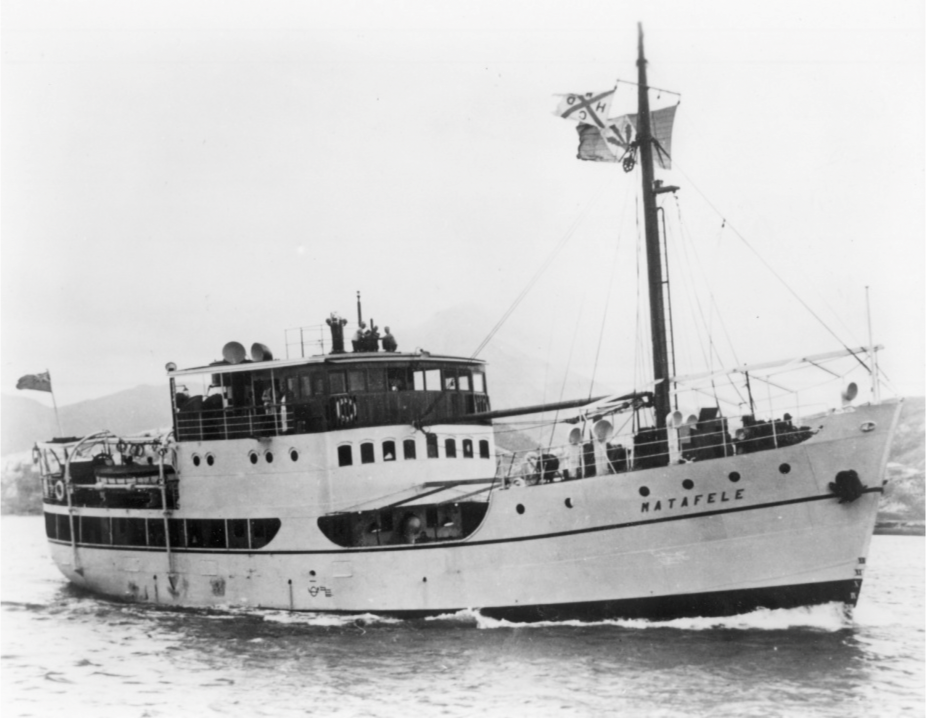
On 26 June 1944 the Naval Officer in Charge New Guinea ordered Matafele to break radio silence and report her position, but again no reply was received. This triggered a wide scale search, by sea and air, off the coast of Papua and out into the Coral Sea; but no sign of her was discovered. Several weeks later some wreckage thought to be from Matafele was found off the south coast of Papua, including a boat oar with Matafele carved into the blade. None of the wreckage showed signs of damage due to enemy action. A Board of Inquiry was subsequently convened and it was presumed that HMAS Matafele foundered sometime on 20 June 1944, due to bad weather in the Coral Sea, with the loss of all hands which included four officers, 20 ratings and 13 Melanesian seamen.
The wreck has not been found.[42]
13 Aug 1944. The Fairmile HMAS ML 430 was lost when being fired upon by another Fairmile, ML 819, which mistook her for an enemy submarine when hunting suspected Japanese boats off New Guinea. Her wreck has not been located.[43] Two members of ML 430′s crew were slightly wounded.[44]
12 November 1944. HMAS Marlean, a channel patrol boat, caught fire in Sydney Harbour, and was burnt to the waterline. Despite efforts made to sink the burning wreck by gunfire, the flames reached her depth charges, and the resultant explosion started a scrub fire in George’s Heights and damaged homes in Watsons Bay and Balmoral.[45]
The Fairmile HMAS ML 827 sank on 20th November 1944 in the tow of Cambrian Salvor after hitting an uncharted reef off Jacquinot Bay in New Britain. Another wooden vessel, her wreck is listed as located due to her proximity to shore.
3 March 1945. HMAS Steady Hour, an air-sea rescue craft, caught fire off the Northern Territory. She was subsequently beached and burnt out.[46]
15 May 1945. HMAS Watcher, described as a “mobile port wireless telegraphy and signal station” was engaged in a tow of the ketch Stingray to Thursday Island when she grounded. The ship could not be saved and became a total loss.
16 May 1945. HMAS Fauro Chief, a wooden auxiliary schooner, sank when a jetty collapsed at Milne Bay in New Guinea.
13 June 1945. HMAS Lolita. This patrol vessel was completely wrecked following an explosion and fire alongside a jetty in Madang, New Guinea. Two ratings from the shore base staff suffered severe burns and later passed away in hospital.
13 Sep 1947. The corvette HMAS Warrnambool sank after striking a mine during clearance operations near Great Barrier Reef. The ship is classified as a war loss due to the mines being laid for defensive purposes in WWII. Four ratings were killed in the explosion or from injuries sustained. Navy divers in May 1948 recovered a number of items, including the ship’s bell. A salvage operation was commissioned but cancelled due to expert opinion the ship would break up if lifted.[47]
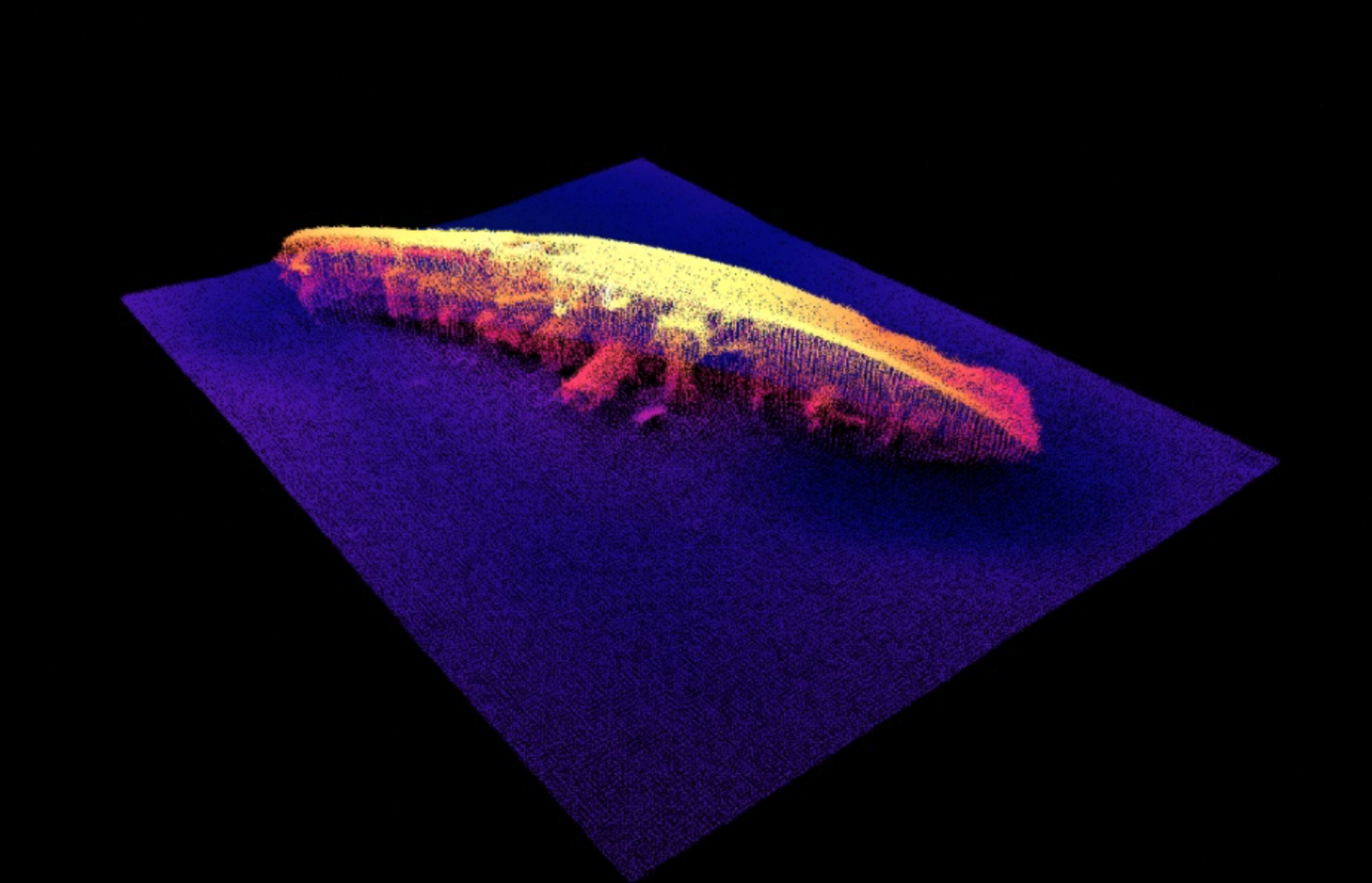
In table form the RAN’s WWII sunken ships therefore look like this, with the lost ships in bold:
| Date of loss | Ship | Type | Location | Wreck located? | Fatalities
found |
Fatalities
lost |
|
| 1 | 14 Sep 1914 | HMAS AE1 | Submarine | Duke of York Island, New Guinea | Yes | 35 | |
| 2 | 30 Apr 1915 | HMAS AE2 | Submarine | Turkey | Yes | 0 | |
| 3 | 20 Nov 1940 | HMAS Goorangai | Minesweeper | South of Melbourne | Yes | 24 | |
| 4 | 30 Jun 1941 | HMAS Waterhen | Destroyer | Mediterranean | No | 0 | |
| 5 | 19 Nov 1941 | HMAS Sydney | Cruiser | Off Western Australia | Yes | 645 | |
| 6 | 27 Nov 1941 | HMAS Parramatta | Destroyer | Mediterranean | No | 138 | |
| 7 | 26 Jan 1942 | HMAS Sirocco | Patrol Boat | Hobart | Yes | 0 | |
| 8 | 19 Feb 1942 | HMAS Mavie | Lugger | Darwin | Yes | 0 | |
| 9 | 19 Feb 1942 | Kelat | Coal hulk | Darwin | Yes | 0 | |
| 10 | 19 Feb 1942 | Karalee | Lighter | Darwin | No | 0 | |
| 11 | 1 Mar 1942 | HMAS Perth | Cruiser | Sunda Strait, Indonesia | Yes | 347 | |
| 12 | 4 Mar 1942 | HMAS Yarra | Sloop | South of Java | No | 138 | |
| 13 | 9 Apr 1942 | HMAS Vampire | Destroyer | East of Sri Lanka | No | 9 | |
| 14 | 12 May 1942 | Uribes | steel schooner | Off Rottnest Island, WA | Yes | 0 | |
| 15 | 31 May 1942 | HMAS Kuttabul | Accommodation vessel | Sydney, NSW | Yes | 21 | |
| 16 | 16 Jun 1942 | HMAS Nestor | Destroyer | Mediterranean | No | 4 | |
| 17 | 2 July 1942 | HMAS Nereus | Cabin cruiser | Sydney Harbour | Yes | 0 | |
| 18 | 8-9 Aug 1942 | HMAS Canberra | Cruiser | Savo Island, Pacific | Yes | 84 | |
| 19 | 12 Sep 1942 | Hulda | Launch | Buna, New Guinea | Yes | 0 | |
| 20 | 23 Sep 1942 | HMAS Voyager | Destroyer | East Timor | Yes | 0 | |
| 21 | 23 Sep 1942 | HMAS Siesta | Patrol vessel | Off Fremantle WA | Yes | 0 | |
| 22 | 1 Dec 1942 | HMAS Armidale | Corvette | South of Timor | No | 101 | |
| 23 | 22 Jan 1943 | HMAS Patricia Cam | Lugger | Off the Northern Territory coast | No | 8 (9) | |
| 24 | 11 Apr 1943 | Yampi Lass | Lighter | Darwin Harbour | Yes | 0 | |
| 25 | 7 May 1943 | HMAS Adele | Steam yacht | Port Kembla, NSW | Yes | 0 | |
| 26 | 10 May 1943 | HMAS Maroubra | Cutter | Milingimbi | Yes | 0 | |
| 27 | 11 Jun 1943 | HMAS Wallaroo | Corvette | West of Fremantle, WA | No | 3 | |
| 28 | 26 Mar 1944 | HMAS Terka | Stores carrier | Madang Harbour | Yes | 0 | |
| 29 | 12 July 1943 | HMAS Silver Cloud | Motor cruiser | Sydney Harbour | Yes | 0 | |
| 30 | 7 Sep 1943 | HMAS Starfish | Raised deck motor cruiser | Wollongong, NSW | Yes | 0 | |
| 31 | 17 Oct 1943[48] | HMAS Gladmor | Auxiliary Patrol Boat | Fremantle, WA | Yes | 0 | |
| 32 | 20 Jun 1944 | HMAS Matafele | Coastal trader | En route to Milne Bay in China Strait | No | 37 | |
| 33 | 13 Aug 1944 | HMAS ML 430 | Fairmile | New Guinea | No | 0 | |
| 34 | 12 Nov 1944 | HMAS Marlean | Patrol boat | Sydney Harbour | Yes | 0 | |
| 35 | 20 Nov 1944 | HMAS ML 827 | Fairmile | New Britain | Yes | 0 | |
| 36 | 3 Mar 1945 | HMAS Steady Hour | Air-sea rescue craft | Off the Northern Territory | Yes | 0 | |
| 37 | 15 May 1945 | HMAS Watcher | Signals ship | Torres Strait | Yes | 0 | |
| 38 | 16 May 1945 | HMAS Fauro Chief | Auxiliary schooner | Milne Bay, New Guinea | Yes | 0 | |
| 39 | 13 Jun 1945 | HMAS Lolita | Patrol vessel | Madang, New Guinea | Yes | 2 | |
| 40 | 13 Sep 1947 | HMAS Warrnambool | Corvette | Great Barrier Reef | Yes | 4 | |
| Total vessels sunk in WWII | 40 | ||||||
| Total lost vessels | 11 | ||||||
| Total lost men | 438 | ||||||
The vessels therefore remaining lost number 11 and are (in chronological order):
HMAS Waterhen
HMAS Parramatta
Karalee
HMAS Yarra
HMAS Vampire
HMAS Nestor
HMAS Armidale
HMAS Patricia Cam
HMAS Wallaroo
HMAS Matafele
HMAS ML 430
Four hundred and thirty-eight men lie with them, and their only grave is the sea. Rest in Peace.
-o-o-O-o-o-
Dr Tom Lewis OAM, a former naval officer, is a military historian and the author of 21 books. His latest work The Sinking of HMAS Sydney – “How sailors lived, fought and died in Australia’s greatest naval disaster” is published by Big Sky, and available at bookshops or online.
-o-o-O-o-o-
[1] Naval Historical Society of Australia. https://navyhistory.au/research/australian-military-ship-losses/ Lyne, Allen. Lost. History of all 45 RAN Ships Lost during Service. Moana Heights SA: Self-published, 2013.
[2] Royal Australian Navy. https://www.navy.gov.au/hmas-ae2
[3] Royal Australian Navy. https://www.navy.gov.au/hmas-ae1
[4] Royal Australian Navy. https://www.navy.gov.au/hmas-goorangai
[5] Royal Australian Navy. https://www.navy.gov.au/hmas-waterhen-i
[6] Royal Australian Navy. https://www.navy.gov.au/hmas-parramatta-II
[7] Drawn from the writer’s Carrier Attack, (with Peter Ingman) published in 2013.
[8] Cassells, Vic. For those in peril – a comprehensive listing of the ships and men of the Royal Australian Navy who have paid the supreme sacrifice in the wars of the twentieth century. Kenthurst, NSW: Kangaroo Press, 1995. (p. 35)
[9] Sometimes spelt – for example in Straczek – as Karalea. Straczek, Joe. The Royal Australian Navy. Ships, Aircraft and Shore Establishments. Sydney: Navy Public Affairs, 1996. (References using this source are not page-dated – the volume is a list sorted alphabetically.)
[10] Cassells, Vic. For those in peril. (p. 34)
[11] See the same author’s “Destroyer doomed from the start – the rewritten story of USS Peary’s final combat action in Darwin 1942”, at https://www.rusi.com.au/Monographs/Monograph5.pdf
[12] Royal Australian Navy. https://www.navy.gov.au/hmas-yarra-ii
[13] Royal Australian Navy. https://www.navy.gov.au/hmas-vampire-i
[14] Royal Australian Navy. “Search for the wreck of HMAS Vampire”. https://www.youtube.com/watch?v=QUgobVFC7Bo
[15] Roar Media. “Hermes, Vampire, and the Grave at the Bottom of the Sea.” 5 July 2019. https://roar.media/english/life/in-the-know/hermes-vampire-and-the-grave-at-the-bottom-of-the-sea
[16] Website: Diving Western Australia’s Shipwrecks. www.divingwawrecks.com
[17] See the same author’s Attack on Sydney Harbour (Big Sky, 2022)
[18] Straczek, Joe. The Royal Australian Navy. Ships, Aircraft and Shore Establishments. Sydney: Navy Public Affairs, 1996.
[19] Ballard, Robert. The Lost Ships of Guadalcanal. NSW: Allen and Unwin, 1993. (see p. 76 and numerous other mentions)
[20] Straczek, Joe. The Royal Australian Navy. Ships, Aircraft and Shore Establishments. Sydney: Navy Public Affairs, 1996.
[21] Royal Australian Navy. https://www.navy.gov.au/hmas-voyager-i
[22] Western Australian Museum. https://museum.wa.gov.au/maritime-archaeology-db/content/hmas-siesta It does not seem certain the vessel was commissioned with HMAS as the prefix, although from this record it seemed a “Sub-Lieutenant Tickle” was in command. As HMAS vessels were commanded by a commissioned officer she has been so titled here.
[23] Lewis, Tom. Teddy Sheean VC. Sydney, Big Sky, 2020. 100 fatalities are normally recorded, but research by John Bradford – as appearing in Teddy Sheean VC – shows 101.
[24] Straczek, Joe. The Royal Australian Navy. Ships, Aircraft and Shore Establishments. Sydney: Navy Public Affairs, 1996.
[25] Royal Australian Navy. https://www.navy.gov.au/hmas-wallaroo
[26] Royal Australian Navy. https://www.navy.gov.au/hmas-silver-cloud
[27] Naval Historical Society of Australia. https://navyhistory.au/research/australian-military-ship-losses/ and Cassells, Vic. For those in peril. (p. 69)
[28] State Library of Queensland. https://www.slq.qld.gov.au/blog/tragedy-hmat-warilda-charles-norman-power
[29] Australian War Memorial. https://www.awm.gov.au/articles/blog/ss-warilda-troopship-hospital-ship-ambulance-transport-wreck
[30] YouTube. https://www.youtube.com/watch?v=ZitQ3Bdbi9s
[31] Rawkins, Alice. State Library of Queensland. “The Tragedy of the HMAT Warilda: Charles Norman Power.”
11 November 2020.
[32] Milligan, Christopher, and John CH Foley. Australian hospital ship Centaur: the myth of immunity. Hendra, Queensland: Nairana Publications, 1993. (p. 28)
[33] Australian Government. https://www.minister.defence.gov.au/media-releases/2023-04-22/montevideo-maru-found#.
[34] Australian War Memorial. https://www.awm.gov.au/articles/encyclopedia/centaur
[35] Mr Petar Djokovic, Historian, Naval History Section | Sea Power Centre – Australia, Department of Defence. Email to the author, September 2023.
[36] Gill, Hermon. Royal Australian Navy 1942-1945. Canberra: Australian War Memorial, 1968. (p. 706)
[37] Gill, Hermon. Royal Australian Navy 1942-1945. Canberra: Australian War Memorial, 1968. (p. 713)
[38] Jubbs, Leslie R. Royal Australian Air Force Marine Section. The forgotten era of men and vessels. Kingsley, WA: self-published, 1997.
[39] BirtwistleWiki. https://birtwistlewiki.com.au/wiki/MV_Wanaka
[40] Alsop, Brian. Australian Army Watercraft. NSW: Topmill, 1996. (pp: 73-74)
[41] Royal Australian Navy. https://www.navy.gov.au/hmas-terka
[42] Royal Australian Navy. https://www.navy.gov.au/hmas-matafele
[43] Wilson, Michael. Royal Australian Navy Profile No. 3. Maritime Patrol. NSW: Topmill, no publication date. (p. 18)
[44] Royal Australian Navy. https://www.navy.gov.au/ml-819
[45] Royal Australian Navy. https://www.navy.gov.au/hmas-marlean
[46] Royal Australian Navy. https://www.navy.gov.au/hmas-steady-hour
[47] Royal Australian Navy. https://www.navy.gov.au/hmas-warrnambool-i
[48] Noted by NHSA as an “HMAS” but Navy do not list her as such. Sometimes seen in records as Gladmore.
Contact MHHV Friend about this article.






